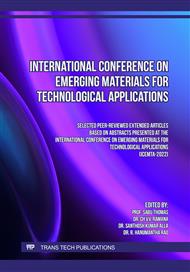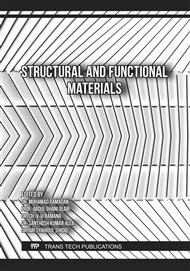[1]
G. Thomson, Air pollution—a review for conservation chemists, Stud. Conserv. 10 (1965) 147–167.
Google Scholar
[2]
A.K. Jorgenson, Does Foreign Investment Harm the Air We Breathe and the Water We Drink? Organ. Environ. 20 (2007) 137-156.
DOI: 10.1177/1086026607302153
Google Scholar
[3]
K.R. Smith, Biofuels, Air Pollution, and Health, Springer, Boston, MA, 1987.
Google Scholar
[4]
R. M. Harrision, Assessment and Reclamation of Contaminated Land, Royal Society of Chemistry, Cambridge UK, 2001.
Google Scholar
[5]
C. S. Rao, Environmental Pollution Control New age international (P) Limited, New Delhi, 1991.
Google Scholar
[6]
I. D. Pulford, C. Watson, Phytoremediation of heavy metal-contaminated land by trees—a review, Environ. Int. 29 (2003) 529– 540.
DOI: 10.1016/s0160-4120(02)00152-6
Google Scholar
[7]
C. Buvaneswaran, K. Arivoli, T. Sivaranjani, E. Menason, K. Vinothkumar, S. Padmini and S. Senthilkumar, Intra-specific variation in response of Neem (Azadirachta indica A. Juss) to elevated CO2 levels and biochemical characterization of differently responding plants, Tropical Plant Res. 3 (2016) 551–557.
DOI: 10.22271/tpr.2016.v3.i3.072
Google Scholar
[8]
K.P. Beckett, P.H. Freer-Smith, G. Taylor, Urban woodlands: their role in reducing the effects of particulate pollution, Environ. Pollut. 99 (1998) 347-360.
DOI: 10.1016/s0269-7491(98)00016-5
Google Scholar
[9]
A. Begum, S. Harikrishna, Evaluation of Some Tree Species to Absorb Air Pollutants in Three Industrial Locations of South Bengaluru, India, J. Chem. 7 (2010) S151-S156.
DOI: 10.1155/2010/398382
Google Scholar
[10]
B. Simran, M. Gupta, N. Dohare, A. Goel, R. Gupta, S. Nanda, Pollution controlling ability of plant species growing on college campus in Delhi, India, Pollut. Res. 38 (2019) S23-S29.
Google Scholar
[11]
A. E. Creamer and B. Gao, Carbon-Based Adsorbents for Postcombustion CO2 Capture: A Critical Review, Environ. Sci. Technol. 50 (2016) 7276−7289.
DOI: 10.1021/acs.est.6b00627
Google Scholar
[12]
V. Nafisi, M. Hagg, Development of dual layer of ZIF-8/PEBAX-2533 mixed matrix membrane for CO2 capture, J. Memb. Sci. 459 (2014) 244–255.
DOI: 10.1016/j.memsci.2014.02.002
Google Scholar
[13]
S. Rafiq, L. Deng, M. Hagg, ChemBioEng Rev. 3 (2016) 68–85.
Google Scholar
[14]
H. Yang, Z. Xu, M. Fan, R. Gupta, R. B.Slimane, A. E Bland, I. Wright, Progress in carbon dioxide separation and capture: a review, J. Environ. Sci. 20 (2008) 14–27.
DOI: 10.1016/s1001-0742(08)60002-9
Google Scholar
[15]
X. Jiang, A review of physical modelling and numerical simulation of long-term geological storage of CO2, Applied Energy 88 (2011) 3557–3566.
DOI: 10.1016/j.apenergy.2011.05.004
Google Scholar
[16]
A.M. Omer, Energy Analysis and Proposals for Sustainability from the Energy Transition, Renew. Sustain. Energy Rev. 12 (2008) 2265-2300.
Google Scholar
[17]
K.M. Sabil, B. Partoon, Recent advances on carbon dioxide capture through a hydrate-based gas separation process, Curr. Opin. Green Sustain. Chem. 11 (2018) 22-26.
DOI: 10.1016/j.cogsc.2018.03.006
Google Scholar
[18]
J. He, Y. Liu, Z. Ma, S. Deng, R. Zhao, L. Zhao A Literature Research on the Performance Evaluation of Hydrate-based CO2 Capture and Separation Process, Energy Procedia 105 (2017) 4090-4097.
DOI: 10.1016/j.egypro.2017.03.867
Google Scholar
[19]
N. Dave, T. Do, G. Puxty, R. Rowland, P.H.M. Feron, M.I. Attalla, CO2 capture by aqueous amines and aqueous ammonia–A Comparison, Energy Procedia 1 (2009) 949-954.
DOI: 10.1016/j.egypro.2009.01.126
Google Scholar
[20]
A. Wahby, J. Silvestre-Albero, A. Sepúlveda-Escribano, F. Rodríguez-Reinoso, CO2 adsorption on carbon molecular sieves, Microporous Mesoporous Mater. 164 (2012) 280-287.
DOI: 10.1016/j.micromeso.2012.06.034
Google Scholar
[21]
A. I. Osman, M. Hefny, M.I.A.A. Maksoud, A.M. Elgarahy, D.W. Rooney, Recent advances in carbon capture storage and utilisation technologies: a review, Environ. Chem. Lett. 19 (2021) 797-849.
DOI: 10.1007/s10311-020-01133-3
Google Scholar
[22]
D.Y.C. Leung, G. Caramanna, M.M. Maroto-Valer, An overview of current status of carbon dioxide capture and storage technologies, Renew Sustain Energy Rev. 39 (2014) 426-443.
DOI: 10.1016/j.rser.2014.07.093
Google Scholar
[23]
R. Lal, Carbon sequestration, Philos Trans R Soc Lond B Biol Sci 363 (2008) 815-830.
Google Scholar
[24]
Y. Tokiwa, B. P. Calabia, C. U. Ugwu, S. Aiba, Biodegradability of Plastics, Int. J. Mol. Sci. 10 (2009) 3722–3742.
DOI: 10.3390/ijms10093722
Google Scholar
[25]
S. Doo, A. Chae, D. Kim, T. Oh, T. Y. Ko, S. J. Kim, D. Koh, C. M. Koo, Mechanism and Kinetics of Oxidation Reaction of Aqueous Ti3C2Tx Suspensions at Different pHs and Temperatures, ACS Appl. Mater Interfaces 13 (2021) 22855-22865.
DOI: 10.1021/acsami.1c04663
Google Scholar
[26]
Z. Jiang, V. Alexandrov, Electrocatalytic Activity of Oxygen-Functionalized Carbon Electrodes for Vanadium Redox Flow Batteries from Free-Energy Calculations, ACS Appl. Energy Mater. 3 (2020) 7543-7549.
DOI: 10.1021/acsaem.0c00972
Google Scholar
[27]
D. Polino, E. Grifoni, R. Rousseau, M. Parrinello, V. Glezakou, How Collective Phenomena Impact CO2 Reactivity and Speciation in Different Media, J. Phys. Chem. A 124 (2020) 3963-3975.
DOI: 10.1021/acs.jpca.9b11744
Google Scholar
[28]
M. Kowacz, G. H. Pollack, Moving Water Droplets: The Role of Atmospheric CO2 and Incident Radiant Energy in Charge Separation at the Air-Water Interface, J. Phys. Chem. B 123 (2019) 11003-11013.
DOI: 10.1021/acs.jpcb.9b09161
Google Scholar
[29]
N. Stolte, D. Pan, Large Presence of Carbonic Acid in CO2-Rich Aqueous Fluids under Earth's Mantle Conditions, J. Phys Chem. Lett. 10 (2019) 5135-5141.
DOI: 10.1021/acs.jpclett.9b01919
Google Scholar
[30]
D. Aaron, C. Tsouris, Separation of CO2 from Flue Gas: A Review, Sci. Technol. 40 (2005) 321–348.
Google Scholar
[31]
P. Pakzad, M. Mofarahi, M. Ansarpour, M. Afkhamipour, Chang-Ha Lee, "CO2 absorption by common solvents", in Advances in carbon capture, M.R. Rahimpour, M. Farsi (Woodhead Publishing,, Cambridge), 51-87.
DOI: 10.1016/b978-0-12-819657-1.00003-7
Google Scholar
[32]
A. S. Mahadevi and G. N. Sastry, Cation-π interaction: its role and relevance in chemistry, biology, and material science, Chem. Rev. 113 (2013) 2100-2138.
DOI: 10.1021/cr300222d
Google Scholar
[33]
A. S. Mahadevi and G. N. Sastry, Cooperativity in Noncovalent Interactions, Chem. Rev. 116 (2016) 2775.
DOI: 10.1021/cr500344e
Google Scholar
[34]
Ken Arnold, Maurice Stewart, in "Design of Gas handling systems and facilities", in Surface Production Operations, Ken Arnold, Maurice Stewart (Gulf professional publishing, England), 19-20.
DOI: 10.1016/b978-088415822-6/50001-5
Google Scholar
[35]
Z. Liang, W. Rongwong, H. Liu, K. Fu, H. Gao, F. Cao, R. Zhang, T. Sema, A. Henni, K. Sumon, D. Nath, D. Gelowitz, W. Srisang, C. Saiwan, A. Benamor, M. Al-Marri, H. Shi, T. Supap, C. Chan, Q. Zhou, M. Abu-Zahra, M. Wilson, W. Olson, R. Idem, P. Tontiwachwuthikul, Recent progress and new developments in post-combustion carbon-capture technology with amine based solvents, Int. J. Greenh. Gas Control, 40 (2015) 26-54.
DOI: 10.1016/j.ijggc.2015.06.017
Google Scholar
[36]
J. M. Berg, J, L, Tymoczko, L. Stryer, Biochemistry. 5th edition. New York: W H Freeman; 2002. Section 1.3, Chemical Bonds in Biochemistry.
Google Scholar
[37]
"Found in Translation": predicting outcomes of complex organic chemistry reactions using neural sequence-to-sequence models. P. Schwaller, T. Gaudin, D Lanyi, C. Bekas, T. Laino. Chem. Sci., 2018, 9, 6091-6098
DOI: 10.1039/c8sc02339e
Google Scholar
[38]
Molecular Transformer: A Model for Uncertainty-Calibrated Chemical Reaction Prediction. P. Schwaller, T. Laino, T. Gaudin, P. Bolgar, C. Bekas, A. A. Lee. ACS Cent. Sci. 2019, 5, 9, 1572–1583
DOI: 10.1021/acscentsci.9b00576
Google Scholar
[39]
IBM RXN for chemistry. https://rxn.res.ibm.com.
Google Scholar
[40]
X. Yang, Y. Wang, R. Byrne, G. Schneider, S. Yan, Concepts of Artificial Intelligence for Computer-Assisted Drug Discovery, Chem. Rev. 119 (2019) 10520-10594.
DOI: 10.1021/acs.chemrev.8b00728
Google Scholar
[41]
Information on https://www.ibm.com/blogs/research/2019/10/ibm-brings-ai-retrosynthetic-analysis-to-the-cloud
Google Scholar
[42]
Information on https://www.rdworldonline.com/ibm-platform-uses-ai-to-predict-chemical-reactions/
Google Scholar
[43]
Marvin 21.9.0, 20201, ChemAxon software.
Google Scholar
[44]
M. J. Frisch, G. W. Trucks, H. B. Schlegel, G. E. Scuseria, M. A. Robb, J. R. Cheeseman, G. Scalmani, V. Barone, B. Mennucci, G. A. Petersson, H. Na-katsuji, M. Caricato, X. Li, H. P. Hratchian, A. F. Izmaylov, J. Bloino, G.Zheng, J. L. Sonnenberg, M. Hada, M. Ehara, K. Toyota, R. Fukuda, J. Hasegawa, M. Ishida, T. Nakajima, Y. Honda, O. Kitao, H. Nakai, T. Vreven, J. A. Montgomery Jr., J. E. Peralta, F. Ogliaro, M. Bearpark, J. J. Heyd, E. Brothers, K. N. Kudin, V. N. Staroverov, R. Kobayashi, J. Normand, K. Raghavachari, A. Rendell, J. C. Burant, S. S. Iyengar, J. Tomasi, M. Cossi, N. Rega,J. M. Millam, M. Klene, J. E. Knox, J. B. Cross, V. Bakken, C. Adamo, J.Jaramillo, R. Gomperts, R. E. Stratmann, O. Yazyev, A. J. Austin, R. Cammi,C. Pomelli, J. W. Ochterski, R. L. Martin, K. Morokuma, V. G. Zakrzewski,G. A. Voth, P. Salvador, J. J. Dannenberg, S. Dapprich, A. D. Daniels, Ö.Farkas, J. B. Foresman, J. V. Ortiz, J. Cioslowski, D. J. Fox, Gaussian 09, Revision C.01, Gaussian, Inc., Wallingford CT, 2009.
Google Scholar
[45]
A. Amalraj, A. Pius, S. Gopi, S. Gopi, Extract of neem (Azadirachta indica) leaf exhibits bactericidal effect against multidrug resistant pathogenic bacteria of poultry, J. Tradit. Complement Med. 7 (2017) 205–233.
DOI: 10.1002/vms3.511/v1/review1
Google Scholar
[46]
E. Ali, Md. S. Islam, Md. I. Hossen, Mst. M. Khatun, Md. A. Islam, Extract of neem (Azadirachta indica) leaf exhibits bactericidal effect against multidrug resistant pathogenic bacteria of poultry, Vet. Med. Sci. (2021) 1-7.
DOI: 10.1002/vms3.511/v2/response1
Google Scholar
[47]
P. Pattanayak, P. Behera, D. Das, S. K. Panda, Ocimum sanctum Linn. A reservoir plant for therapeutic applications: An overview, Pharmacogn Rev. 4 (2010) 95–105.
DOI: 10.4103/0973-7847.65323
Google Scholar
[48]
S. Shaheena, A. D. Chintagunta, V. R. Dirisala, N. S. Sampath Kumar, Extraction of bioactive compounds from Psidium guajava and their application in dentistry, AMB Expr 9 (2019) 208.
DOI: 10.1186/s13568-019-0935-x
Google Scholar
[49]
S.B. Chandrasekar, M. Bhanumathy, A.T. Pawar, T. Somasundaram, Phytopharmacology of Ficus religiosa, Pharmacogn Rev. 4 (2010) 195–199.
DOI: 10.4103/0973-7847.70918
Google Scholar



